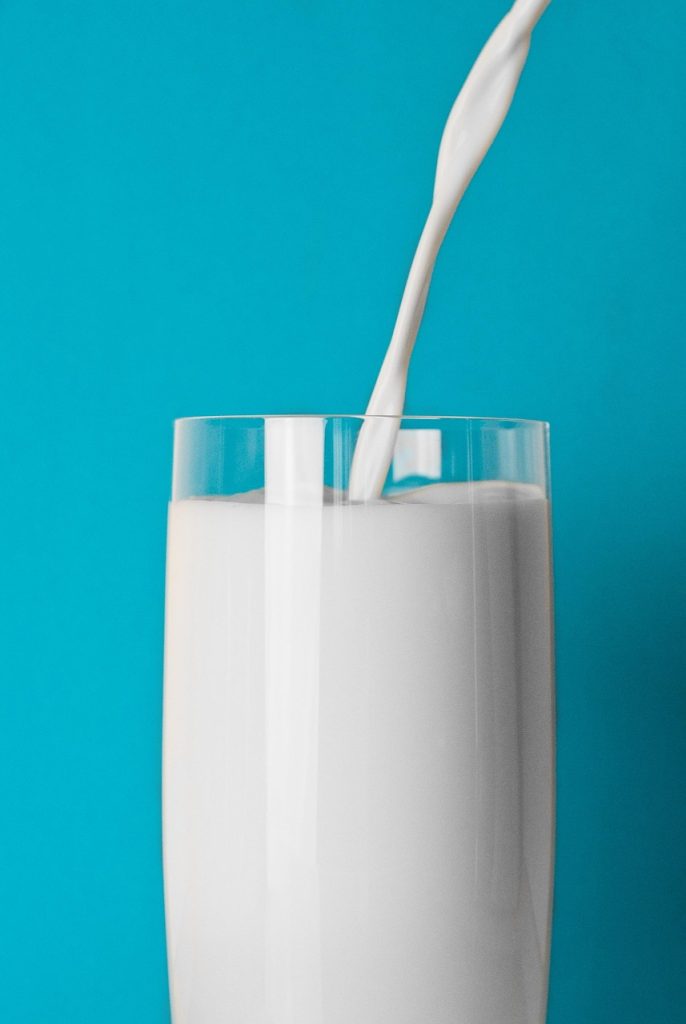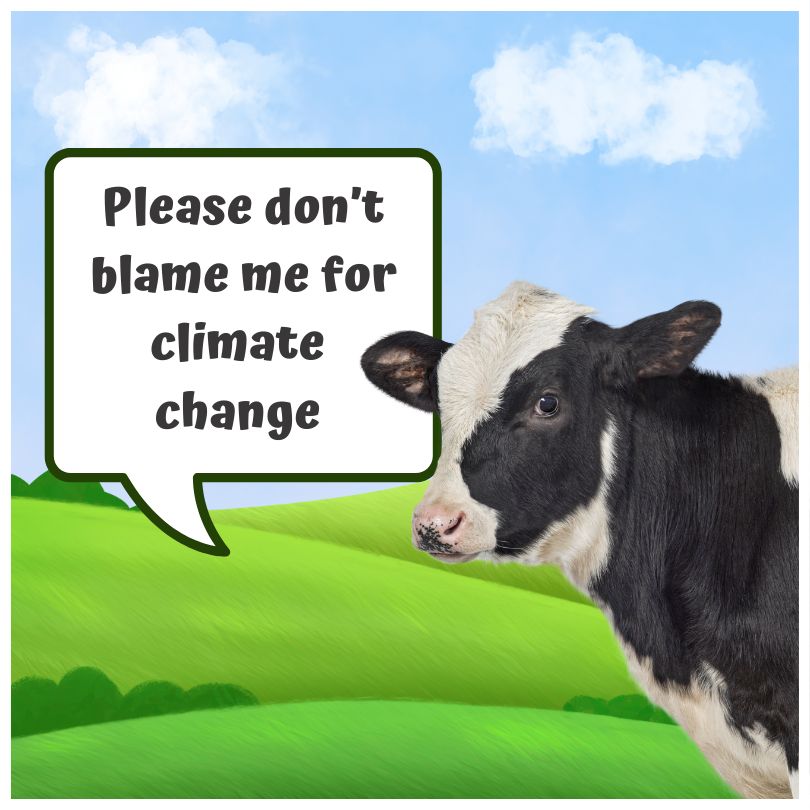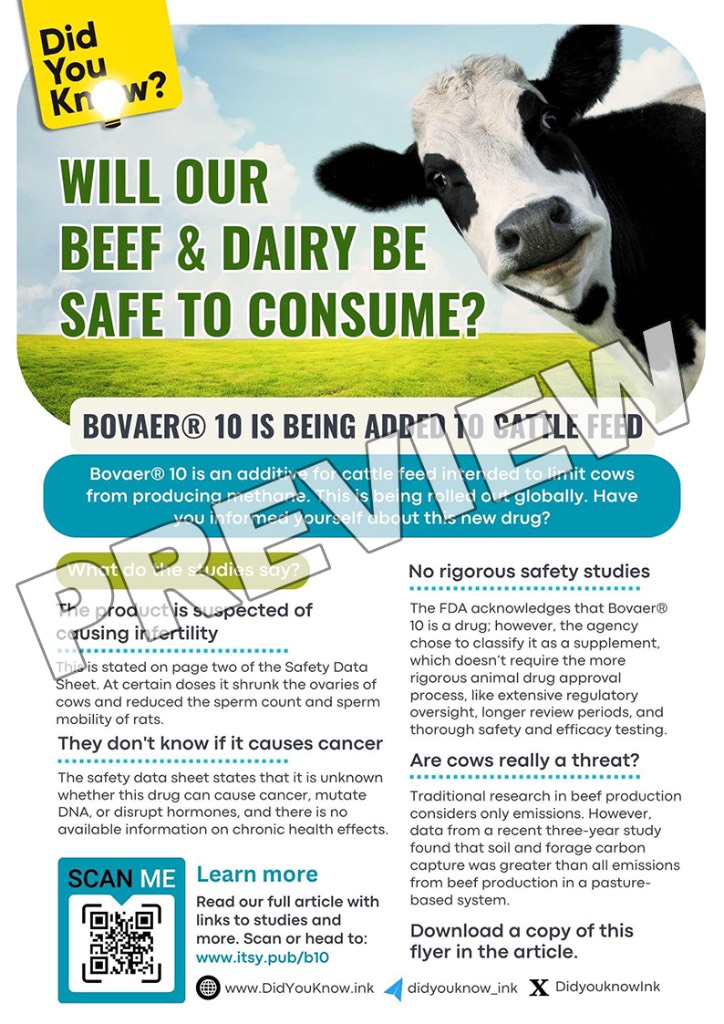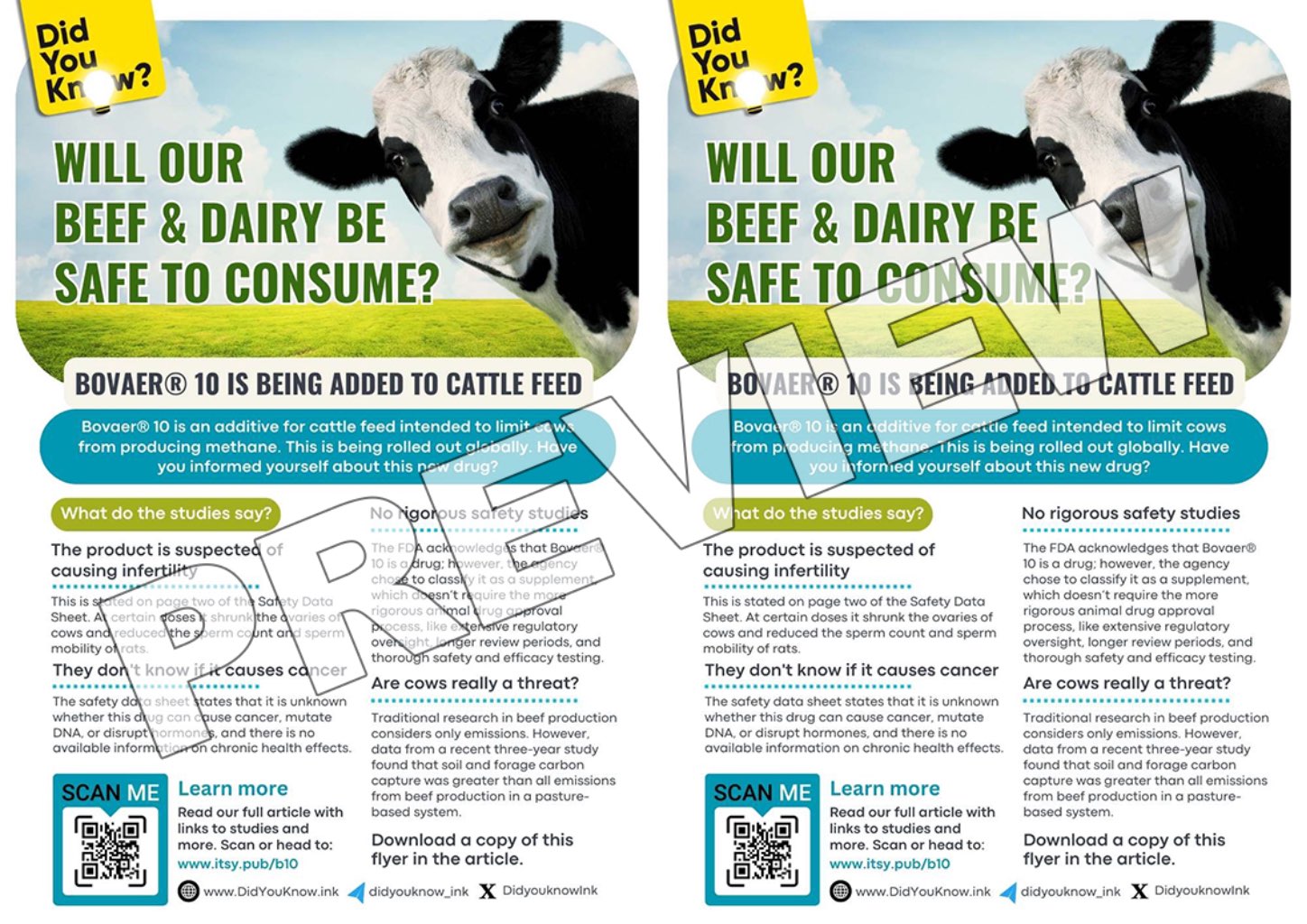Did you know that a drug by the name of Bovaer® 10 will soon be added to cattle feed in Australia, with the intent of lowering the amount of methane produced by cows?
This is being done in the name of "climate change"; however, there has been conjecture amongst experts regarding the calculation of cattle emissions and whether or not they pose a threat at all. Additionally, tens of thousands of scientists worldwide have voiced their disagreement about the concept of man-made climate change, but more on that later.
As of the date this article was published, there are still farmers who have not yet incorporated Bovaer® 10 in their cattle feed, so we still have time to present them with information they may not be aware of. You may wish to show your local butcher or farmer this article, or print out the flyer down below. To skip directly to the flyer, click here.
How does Bovaer® 10 reduce the methane produced by cows?

The additive inhibits enzymes that are responsible for combining carbon dioxide and hydrogen during digestion, which would normally form the methane that is expelled by the cow.
Blocking these enzymes prevents a great percentage of this methane from being formed.
Bovaer® 10 consists of silicon dioxide, propylene glycol, and its active ingredient, 3-nitrooxypropanol (3-NOP).
3-NOP is the sole component of the product subjected to safety testing. The product hasn’t been tested as a whole.
The Safety Data Sheet (SDS) reveals that little is known about the potential side effects of 3-NOP (The active ingredient in Bovaer® 10).
The SDS states that the classification of the product is hazardous according to Regulation (EC) 1272/2008.
By reading through the SDS, you will come to notice that there is a LOT that is unknown about this drug's potential side effects. It is a novel, experimental drug that is planned to be distributed globally, making our cattle and the people who consume their by-products test subjects on a phenomenal scale.
What they DON’T know for certain about 3-NOP:

- It is NOT known if the product is carcinogenic (capable of causing cancer).
- It is NOT known if the product is mutagenic (can change DNA, e.g., gene mutation).
- It is NOT known if the product has endocrine-disrupting properties (disrupts hormones).
- There is NO available information on toxicity to specific target organs for either single exposure or long-term exposure.
- There is NO available information on chronic health effects.
This is all stated in SECTION 11: Toxicological Information of the Safety Data Sheet.
Why don’t they know?
This is due to a combination of:
- Inconclusive study results, for example, the results of the carcinogenicity and genotoxity studies in Wistar rats were inconclusive. They found tumours in rats, which may be due to the 3-NOP treatment. They claim that it shouldn’t be a concern to the consumer because the 3-NOP is metabolised by the cow, but they don’t appear to take into account that the metabolite NOPA has been detected in milk, which we will discuss further down (source: 3.2.5 Safety For the Consumer, page 26).
- The most extensive "long-term" safety study that we could find on cows was only 20 weeks long (source: 3.3.3. Long-term studies in animals, page 29).
- Being a new drug, the potential long-term adverse effects may not have had time to manifest.
Yet they want to rush this product out across the globe?
So what DO they know about this experimental drug?
- That it is suspected of damaging fertility. This admission can be found on page 2 of the Safety Data Sheet.
- That it may cause male infertility and dangers to reproductive organs (source: Bovaer® 10 label, page 4).
- Skin and eye irritation.
- The FDA specifically warns that it is dangerous for human use and cautions those handling it to use personal protective equipment (source: Bovaer® 10 label, page 4).
No rigorous safety testing
In a letter from the Food & Drug Administration (FDA) to the Director of Global Nutritional Health Regulatory, Dr. G. Allen Bridges, it was acknowledged that Bovaer® 10 is a drug; however, the agency chose to classify it as a supplement, thus averting the more rigorous animal drug approval process, which would have required extensive regulatory oversight, longer review periods, and thorough safety and efficacy testing of the product, in comparison to the frequently self-determined safety evaluations for feed supplements. (Source: Letter from the U.S. Food and Drug Administration Veterinary Medicine).
Ovarian shrinkage and reduced sperm count
Research on cows found that 3-NOP given at doses of 200 mg/kg (complete feed) resulted in ovarian shrinkage, as well as a reduction in heart weight in the higher dosed group (source: Outcome of assessment of 3-Nitrooxypropanol-Assessment - Safety for the target species, page 26).
In rat studies, reduced sperm count and sperm mobility were observed in most male rats at the 300 mg/kg dosage, with no improvement 13 weeks thereafter (source: section 3.2.3.4 Subchronic toxicity studies, page 18).
Some of the sample sizes in the studies were very small, and two cows from the smaller study, which consisted of 4 cows per group, were euthanised prematurely due to reduced feed intake and lethargy—one from the 400 mg/kg group and one from the 800 mg/kg group (source: 3.2.3.8. Summary on ADME, residues, and toxicological studies, page 23).
Given that Bovaer® 10 will be added to cattle feed, we should consider that in most cases it is likely not administered directly to each cow. As a result, it would be difficult to control the precise quantity that each cow consumes, and as the animal studies show, dosage is a very critical factor.
Additionally, taking into account that infertility is a suspected side effect of this drug, it beggars belief that this has been approved to be distributed so widely. Why are these big pharmaceutical companies and regulators happy to take a gamble with our food source and the health of consumers?
Metabolites of 3-NOP found in milk

We have been told that Bovaer® 10 doesn’t end up in the final consumable products, but that is not entirely true.
In safety studies, metabolites (substances left-over after the cows digestive system breaks down the drug) of 3-NOP were detected in milk (Source: 2.2.1. Safety for the target species).
It is important to note that there are no long-term studies that have been specifically conducted on the human health effects of consuming 3-NOP metabolites. Regulatory bodies rely on toxicological data and exposure assessments for 3-NOP and automatically apply the same safety threshold to the metabolite called NOPA.
What is known, however, is that NOPA is what is considered responsible for the potentially irreversible infertility in male rats (source: 3.2.3.8. Summary on ADME, residues, and toxicological studies, page 22).
Keep in mind that rats are used in laboratory testing because almost all human genes that are associated with diseases have counterparts in the rat genome. Does this mean humans could experience the same adverse infertility effects from NOPA as rats if they consume products containing NOPA over a period of time? In the absence of dedicated long-term studies, we are left with a daunting uncertainty about these terrifying risks.
Other studies on 3-NOP metabolites, which have been conducted on both animal and human cells in vivo (in the body) and in vitro (outside the body), returned conflicting results on its genotoxicity (cell damage by chemical agents), this coincides with the safety data sheet stating that mutagenicity is unknown (source: 3.2.3.3. Conclusions on genotoxicity).
Are you willing to be a guinea pig?

I think now is a good time to reflect back on the tragedy that was thalidomide. A drug that was touted by the medical industry as “safe and effective,” only to result in disastrous malformations to tens of thousands of babies whose mothers took the drug.
Environmental impacts of using Bovaer® 10 as a feed additive
The studies on 3-NOP, as part of the Bovaer® 10 approval process, do not provide extensive research on environmental impacts beyond methane reduction. They assume that the small quantities of the additive used in livestock feed will not harm the environment. More comprehensive environmental studies would have provided a stronger basis for assessing long-term and broader ecological effects.
How can regulators jump the gun and allow this drug to be administered to cattle globally without these valuable studies?
It is important to remember that the safety data sheet states that 3-NOP is “not readily biodegradable,” which means it resists decomposition by microorganisms like bacteria and fungi that would typically break down organic materials over time.
This suggests that the substance and its metabolites may persist in the environment for long periods, potentially contributing to environmental pollution, again leaving the consequences unknown, which is concerning considering in vitro testing showed genotoxicity (DNA damage) in bacteria.
The biogenic carbon cycle
Biogenic methane is produced by sources like microbial processes in natural environments, including wetlands, oceans, and the digestive systems of ruminant animals like cows.
- It begins with CO₂ that is already in the atmosphere.
- CO₂ is absorbed by plants and forage, where it is turned into carbohydrates like cellulose and starch that are consumed by the cow.
- The cow's digestive system combines carbon dioxide and hydrogen molecules to form methane, which is returned to the atmosphere and undergoes oxidation by hydroxyl radicals (OH) and other atmospheric reactants, breaking it back down to CO₂.
- This process of methane breaking back down to CO₂ takes around 8-10 years. It is simply a recycling process.

Why are they picking on cows?
While our cows that provide us with sustenance are being demonised for apparently causing "climate change" by simply burping and being part of the natural carbon cycle, giant corporations are making huge profits producing huge amounts of methane.
A 2021 study found that fracking (shale gas extraction via hydraulic fracturing) has a large greenhouse gas footprint, greater than that of coal or other fossil fuels, and is responsible for approximately 40% of the total global increase in atmospheric methane from all sources since 2005 (source: Department of Ecology & Evolutionary Biology, Cornell University).
Many questions remain about the dangers of fracking, with mounting evidence raising serious red flags about its impact on drinking water and air pollution.
Is this hysteria about cows all just a load of bull?

A recent 3-year study by Nebraska University examined not just the methane emissions of cattle but also the carbon capture (carbon sequestration) that occurred in the soil and forage where the cows grazed, which offset the CO₂ they produced.
They compared two beef production systems in Nebraska: a traditional pasture-based system and a partial confinement-based system (factory farm). What they found was that the pasture-based system sequestered significant amounts of carbon in the soil and forage, offsetting 138% of its total methane emissions, making them potentially carbon-negative (more CO₂ is removed from the atmosphere than emitted). Essentially, the study demonstrates the importance of good beef production management practices and regenerative farming without the need for these feed additives.
Read the full study 'Greenhouse Gas Emissions from Two Beef Systems from Birth to Slaughter in Eastern Nebraska.'
Here is a farmer explaining the value of regenerative farming.
But is carbon dioxide in our atmosphere, at its current levels, really the big scary monster it is made out to be by climate alarmists?
Professor Ian Pilmer discusses how, if we halved the current levels of carbon dioxide in our atmosphere, all plant and animal life would die. He discusses how the earth has been experiencing natural warming and cooling cycles for millions of years.
Short Video:
Full Video:
To learn more about the tens of thousands of scientists who say man-made climate change is a fabrication, read our article: Is the climate change narrative a lie?
Fun Fact
Did you know that DSM, the manufacturer of Bovaer® 10, is a leading investor in a lab-grown meat company named Meatable? This is a company that wants to remove the need for livestock in meat production to save the planet from climate change.
To read more about the unregulated, ultra-processed syn-bio-tech foods that are coming to a supermarket near you, read our article: KEEP IT REAL—Stop Ultra-Processed syn-bio-tech foods.
How can you protect yourself and your loved ones?
- Relay this information to as many people as you know.
- Inform your local farmers and butchers, perhaps show them our flyer.
- Check out this list of Bovaer® 10 Free suppliers here.
Would you like to spread awareness with a flyer?
These flyers link to this article.















Hi.
About 6 or 8 weeks ago, I ordered flyers. Didn't get them. Sent two emails, nobody responded. I thought that you will be happy that somebody will dedicate their time (and petrol) to distribute them.
But I was wrong.
Have a good life.
Regards,
Sarina
I have emailed you.